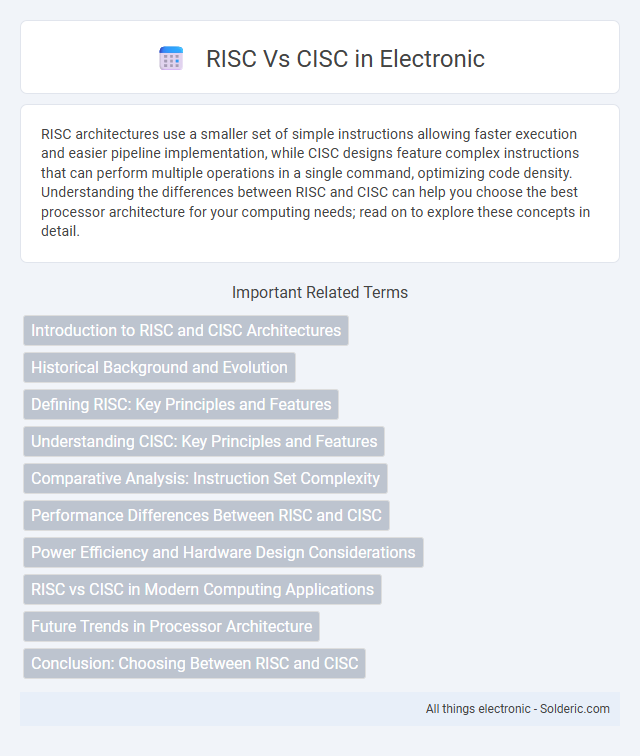RISC architectures use a smaller set of simple instructions allowing faster execution and easier pipeline implementation, while CISC designs feature complex instructions that can perform multiple operations in a single command, optimizing code density. Understanding the differences between RISC and CISC can help you choose the best processor architecture for your computing needs; read on to explore these concepts in detail.
Comparison Table
| Feature | RISC (Reduced Instruction Set Computer) | CISC (Complex Instruction Set Computer) |
|---|---|---|
| Instruction Set | Simple, limited number of instructions | Complex, large number of instructions |
| Instruction Length | Fixed length | Variable length |
| Execution Time | One instruction per clock cycle | Multiple cycles per instruction |
| Memory Usage | More instructions, less complex | Fewer instructions, more complex |
| Complexity | Low design complexity | High design complexity |
| Examples | ARM, MIPS, SPARC | x86, Intel 8086, VAX |
| Pipeline Efficiency | Higher due to uniform instruction length | Lower due to variable instruction length |
| Use Case | Embedded systems, mobile devices | Desktop computers, servers |
Introduction to RISC and CISC Architectures
RISC (Reduced Instruction Set Computer) architecture emphasizes a small, highly optimized set of instructions that execute rapidly, enabling efficient pipelining and simpler hardware design. CISC (Complex Instruction Set Computer) architecture incorporates a broader range of instructions, allowing complex operations with fewer lines of code but potentially slower execution due to intricate decoding. Understanding these fundamental differences helps you choose the appropriate processor type based on performance needs and application complexity.
Historical Background and Evolution
RISC (Reduced Instruction Set Computer) architecture emerged in the early 1980s as a response to the growing complexity of CISC (Complex Instruction Set Computer) designs that dominated the 1970s, emphasizing simplified instructions for faster execution. CISC processors evolved earlier with the intent to minimize the number of instructions per program by incorporating complex instructions that combine multiple low-level operations, benefiting early memory-constrained systems. Over time, RISC's streamlined approach influenced modern CPUs by improving pipeline efficiency and parallelism, while CISC architectures integrated RISC principles to enhance performance and scalability.
Defining RISC: Key Principles and Features
RISC (Reduced Instruction Set Computer) architecture emphasizes a simplified set of instructions designed for efficient execution, enabling faster processing with fewer cycles per instruction. Key principles include fixed instruction length, load/store architecture, and a large number of general-purpose registers that enhance pipeline performance. Your applications benefit from RISC's streamlined design by achieving higher instruction throughput and improved energy efficiency.
Understanding CISC: Key Principles and Features
CISC (Complex Instruction Set Computing) architectures feature a diverse set of instructions capable of executing multi-step operations within single instructions, reducing the number of instructions per program. Key principles include variable-length instruction formats, microcode implementation, and an emphasis on hardware complexity to simplify software development. Understanding CISC helps you recognize how its design optimizes performance for complex tasks by minimizing instruction fetches and leveraging rich instruction sets.
Comparative Analysis: Instruction Set Complexity
RISC (Reduced Instruction Set Computer) features a simplified instruction set with fixed-length instructions designed for rapid execution and easier pipeline implementation, enhancing performance and energy efficiency. In contrast, CISC (Complex Instruction Set Computer) includes a wide variety of complex, variable-length instructions capable of executing multiple low-level operations within a single instruction, optimizing code density but increasing decoding complexity. Your choice between RISC and CISC architectures significantly impacts system design, influencing processor speed, compiler efficiency, and application-specific performance.
Performance Differences Between RISC and CISC
RISC (Reduced Instruction Set Computer) architectures typically offer higher performance through streamlined, fixed-length instructions that enable faster execution and efficient pipelining. CISC (Complex Instruction Set Computer) designs incorporate more complex, variable-length instructions, which can reduce the number of instructions per program but may slow down the clock speed and increase decoding complexity. Your choice between RISC and CISC impacts performance based on workload characteristics, with RISC favoring high-throughput tasks and CISC excelling in specialized, instruction-dense applications.
Power Efficiency and Hardware Design Considerations
RISC processors are designed with a simplified instruction set that allows for lower power consumption and more efficient hardware implementation, making them ideal for mobile and embedded systems where energy efficiency is crucial. In contrast, CISC architectures incorporate complex instructions that require more transistors and power, leading to increased heat generation and more intricate chip design. When optimizing your device for power efficiency, selecting RISC-based processors can result in longer battery life and streamlined hardware design.
RISC vs CISC in Modern Computing Applications
RISC architectures dominate modern computing applications due to their simplified instruction sets that enable higher clock speeds and efficient pipeline processing, enhancing performance in smartphones, tablets, and embedded systems. CISC processors remain prevalent in desktop and server markets where complex instruction sets optimize legacy software performance and support extensive multitasking. The rise of ARM-based RISC chips in data centers and mobile devices underscores a shift toward energy efficiency and scalability in contemporary computing environments.
Future Trends in Processor Architecture
Future trends in processor architecture emphasize integrating RISC's simplified instruction sets with CISC's complex functionality to enhance performance and energy efficiency. Advances in hybrid architectures, such as ARM's big.LITTLE design and Intel's hybrid CPUs, illustrate this convergence by optimizing workload distribution and power management. Emerging technologies, including AI acceleration and quantum computing integration, will further influence the evolution of RISC and CISC architectures toward more specialized and adaptive processor designs.
Conclusion: Choosing Between RISC and CISC
Choosing between RISC and CISC depends on your specific computing needs and application requirements. RISC architectures offer simplified instructions and faster execution for tasks requiring high performance and power efficiency, while CISC designs excel in complex instruction sets ideal for legacy software compatibility and diverse applications. Assessing workload demands and hardware constraints will guide optimal processor selection.
RISC vs CISC Infographic

 solderic.com
solderic.com